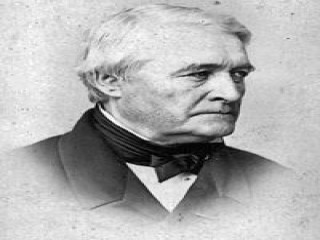
Claude Pouillet biography
Date of birth : 1791-02-16
Date of death : 1868-06-14
Birthplace : Cusance, Doubs, France
Nationality : French
Category : Science and Technology
Last modified : 2010-05-07
Credited as : Physicist and electrical engineer, The sine galvanometre, Ohm's Law
0 votes so far
Claude-Servais-Mathias Pouillet designed the sine galvanometer and the tangent galvanometer and used them to support Ohm’s Law. Claude-Servais-Mathias Pouillet was born in Cuzance, Doubs, France, on February 16, 1790. Pouillet was a French physicist. He supported the work of Ohm and confirmed Ohm’s Law in 1834.
Pouillet designed the sine galvanometer and the tangent galvanometer. The sine galvanometer is similar in appearance to the tangent galvanometer, but has provision to rotate the coil about a vertical axis. One rotates the coil from the magnetic meridian position until it coincides with the vertical plane containing the deflected needle. The current is then proportional to the sine of the angle of rotation. It is more sensitive than the tangent galvanometer and allows the use of a larger needle.
Pouillet’s sine galvanometer
The sine galvanometer, first described by Prof. Claude Pouillet of Paris in 1837, is a precursor of the tangent galvanometer. Like the tangent galvanometer, the sine galvanometer has a coil of wire carrying the current to be measured, and a magnetic compass needle in the middle of the coil. The coil of wire is first oriented in the magnetic north-south direction and the compass needle is acted on only by the horizontal component of the magnetic field of the earth.
The passage of the current sets up a magnetic field perpendicular to the coil, and the compass needle points in the direction of the total magnetic field. The coil is now rotated through an angle &o until the plane of the coil coincides with the needle. Under these conditions, the two torques acting on the needle are due to (a) the magnetic field B of the coil, which is at right angles to the coil, and (b) the component of the earth’s magnetic field perpendicular to the coil: BXsin&o. These two torques just balance each other. Since the value of B is proportional to the current I setting up this field, I is proportional to sin&o. The advantage of this apparatus is that the needle does not have to lie in a uniform magnetic field, and so the compass needle can be relatively large.
Pouillet’s tangent galvanometer
The tangent galvanometer was first described in an 1837 paper by Claude-Servais-Mathias Pouillet, who later employed this sensitive form of galvanometer to verify Ohm’s law. To use the galvanometer, it is first set up on a level surface and the coil aligned with the magnetic north-south direction. This means that the compass needle at the middle of the coil is parallel with the plane of the coil when it carries no current. The current to be measured is now sent through the coil, and produces a magnetic field, perpendicular to the plane of the coil, and directly proportional to the current.
The magnitude of the magnetic field produced by the coil is B; the magnitude of the horizontal component the earth’s magnetic field is B’. The compass needle aligns itself along the vector sum of B and B’ after rotating through an angle O from its original orientation. The vector diagram shows that tanO = B/B’. Since the magnetic field of the earth is constant, and B depends directly on the current, the current is thus proportional to the tangent of the angle through which the needle has turned.
Between 1837 and 1838 he made, independently of John Frederick William Herschel (1792-1871), the first quantitative measurements of the heat emitted by the Sun. His value was circa half the actual one because the level of the atmospheric absorption was uncertain those times, and the problem wasn’t solved until 1888 and 1904. With the Dulong-Petit law he wrongly estimated the temperature of the Sun’s surface to be around 1800 degreeC. This value was corrected in 1879 to 5430 degree C by Joef Stefan (1835-1893).
Pouillet’s pyrrhometer
Water is contained in the cylindrical container a, with the sun-facing side b painted black. The thermometer d is shielded from the Sun by the contained, and the circular plate e is used to align the instrument by ensuring that the container’s shadow is entirely projected upon it. [Reproduced from A.C. Young’s The Sun (revised edition, 1897). Although various scientists had attempted to calculate the Sun’s energy output, the first attempts at a direct measurement were carried out independently and more or less simultaneously by the French physicist Claude Pouillet and British astronomer John Herschel (1792-1871).
Although they each designed different apparatus, the underlying principles were the same: a known mass of water is exposed to sunlight for a fixed period of time, and the accompanying rise in temperature recorded with a thermometer. The energy input rate from sunlight is then readily calculated, knowing the heat capacity of water. Their inferred value for the solar constant was about half the accepted modern value of 1367+4 Watt per square meter, because they failed to account for of absorption by the Earth’s atmosphere.
Poillet works include On atmospheric electricity, (London 1832), Elements de physique experimentale et de meteorologie, (Paris 1856).
Poillet also studied physics of gases. The picture shows a Pouillet’s device for showing that vapour pressure increases under its degree of saturation.
















